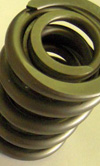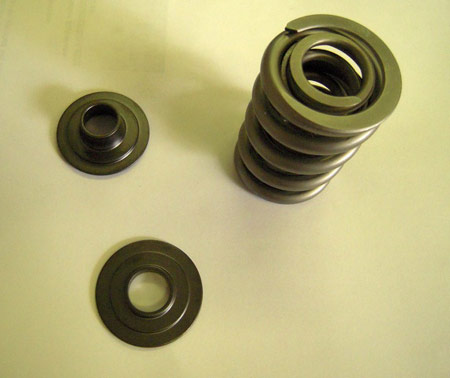Valve springs in the World of Outlaws environment
 In many areas of motorsport, components are pushed to their limit to squeeze out as much performance as possible. Finding that balance between more performance and too high a risk of failure is something that engine builders are constantly wrestling with.
In many areas of motorsport, components are pushed to their limit to squeeze out as much performance as possible. Finding that balance between more performance and too high a risk of failure is something that engine builders are constantly wrestling with.
Ron Shaver of Shaver Engine Specialties, in Torrance, California, builds Tony Stewart's World of Outlaws 410 cu in sprint engines. And, like many other parts of his engines, valve springs are a vital area where risk and reward have to be balanced. We spoke to Ron Shaver to find out the state of his particular art when it comes to valve springs in the harsh environment of World of Outlaws.
Talking about the design he runs, Shaver says, "We have to run fairly high loads in the spring to cope with the valve gear at the rpm we run. We have experimented at length and have developed packages that work well. Currently we run a double spring with an inserted damper on the 410 cu in engines. This current spec of spring is made for the sprint car crowd and for sportsman drag racing. It has an outside diameter of 1.550 in and inside diameter of 1.42 in on the outer spring; the inner spring's diameter is 0.706 in.
He uses the same spring for both intake and exhaust. These springs are made of chrome silicon steel alloy. His supplier uses a proprietary heat treatment and micro-peen combination to give the best possible properties for the material and the best possible surface condition to try to reduce failure-inducing surface defects to an absolute minimum.
The install load is 275 lb, and install height is 2.100 in. Open load is 805 lb with a corresponding open height of 1.200 in. The maximum coil bind is 1.150 in and maximum lift is 0.800 in, Shaver says. The spring has a frequency of 29,368 Hz and, with its damper installed, inner frequency is 28,434 Hz.
If every spring was as good as the best one, life would be much sweeter for everyone using wire valve springs. In fact, Shaver considers valve springs a "voodoo area of the valvetrain. You find one [spring] that works great - and I'll never understand this - and you run them for a year. Then you go to another batch of the same design and the springs don't work the same."
Having worked with every valve spring maker, Shaver has found discrepancies from batch to batch with all of them. There are several theories about the variations in spring reliability. Shaver believes it's the heat treatments used, and cites an example where a batch of springs typically heat treated to 54.1 on the Rockwell C scale were treated to 54.4 and failed.
To try to reduce issues, Shaver carries out a series of his own checks. He makes sure the material is consistent through Rockwell checks, and every single spring goes through a spin-checker and a cycle crush to check it and set it in properly. "We can't check the heat treat and we can't always catch the tiniest of defects, but we work hard at visual inspection and the other physical checks."

While he used to have to finish the ends on his valve springs, Shaver finds the ends on new springs are "pretty well finished; they're well done. We do a visual on all the springs, check them all for pressure on the Spintron and try to run each for a million cycles, checking every 500,000 cycles, the put them in and run them."
Naturally, the spring doesn't work alone, and much work has also gone into developing the components that work alongside the valve spring to make sure they all work well together. While he initially began running steel retainers made of 300M material, he found some breakage. "We made adjustments for that, and in a week we had new tool steel retainers with a different type of shot-peen," he explains.
"We've taken half the spring step on the retainer and put it on the spring seat to cut down on the weight of the retainer, because that's a moving weight and we want to get rid of all the valve gear weight that we can. That helps reduce loads all through the valvetrain - including the spring. We did try titanium retainers, but the spring damper used to eat up the surface of the retainer, so we now stick with steel."
He doesn't flood the springs, as some engine builders do, but he does spray them for cooling from the rocker bar.
"Aside from material or heat treat issues, we have to juggle the amount of direct oil cooling. If we have too little oil you can see it right away because the spring will become straw-coloured. When we see that, we send it right in for testing to confirm the cause of the problem, then we can adjust the cooling accordingly."
And the result of the extra care taken - once confidence is built up in a spring valve gear package - he may even send springs out for a second time after he rebuilds an engine after 550 race miles, meaning a spring could easily stay in an engine for up to 1100 race miles.
With all the development and testing that goes on, it's not a trivial thing to change the spec of the spring. Shaver thinks it will happen only about once a year, sometimes more often, but these changes are usually driven by improvements in material or processes at his spring supplier.
In the harsh environment of the World of Outlaws, upsetting the "voodoo area" is never done lightly at Shaver Engine Specialties.
Fig. 1 - Shaver Engine Specialties uses a double valve spring with inserted damper
Written by Anne Proffit